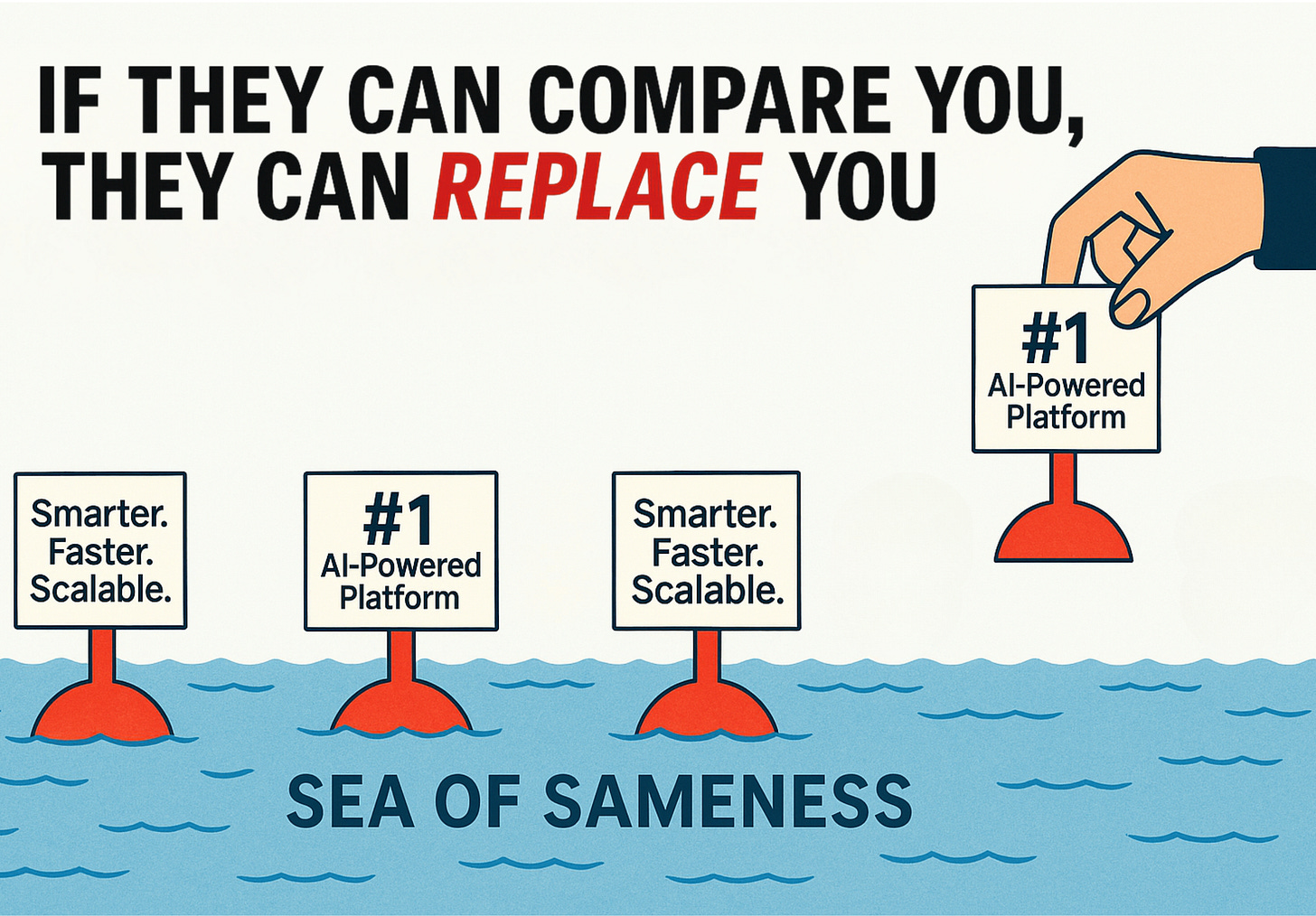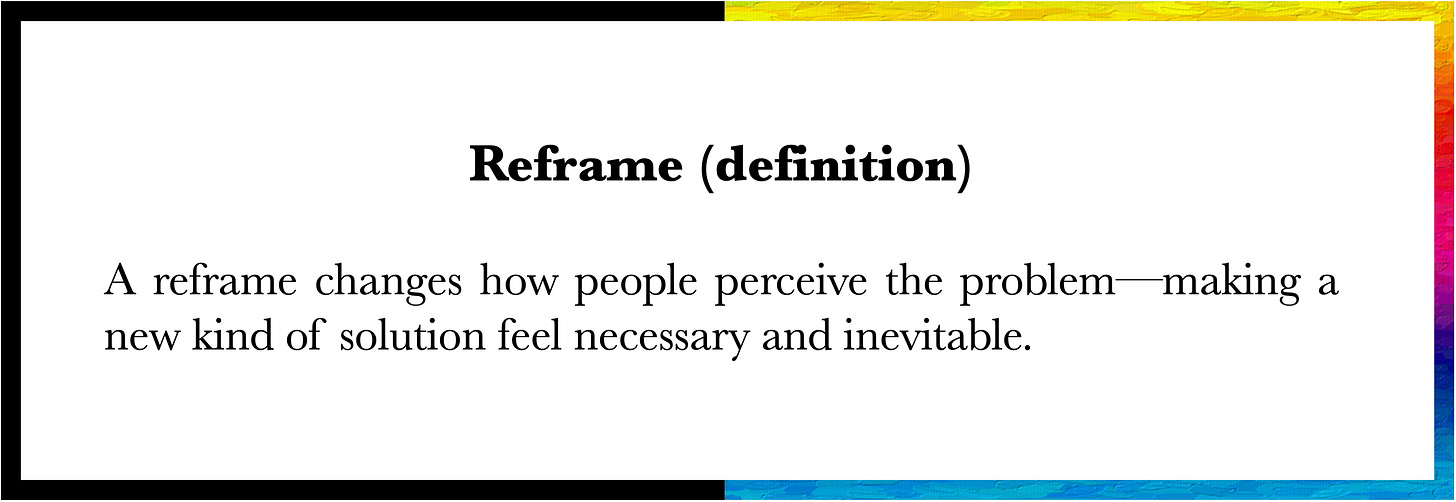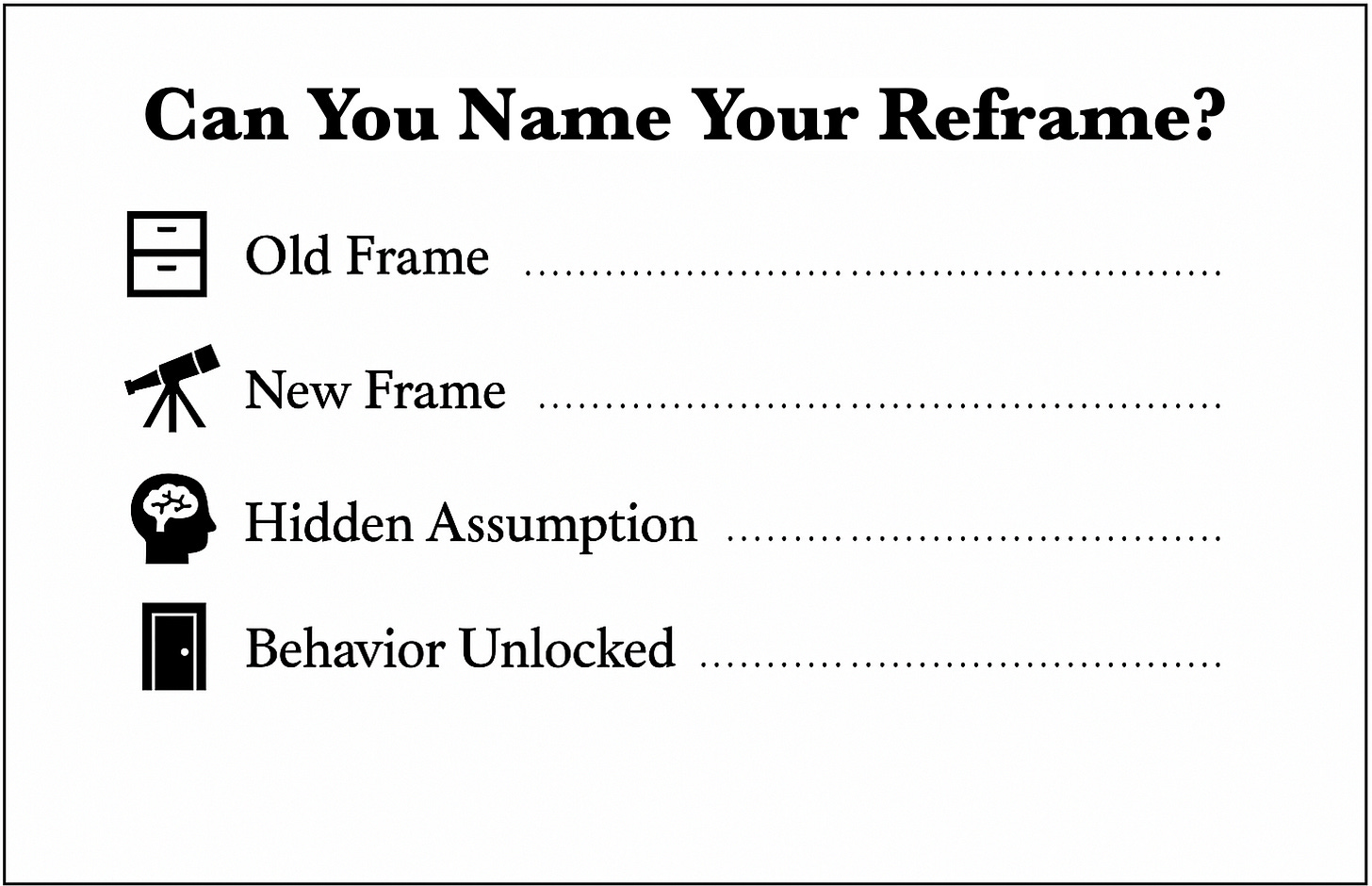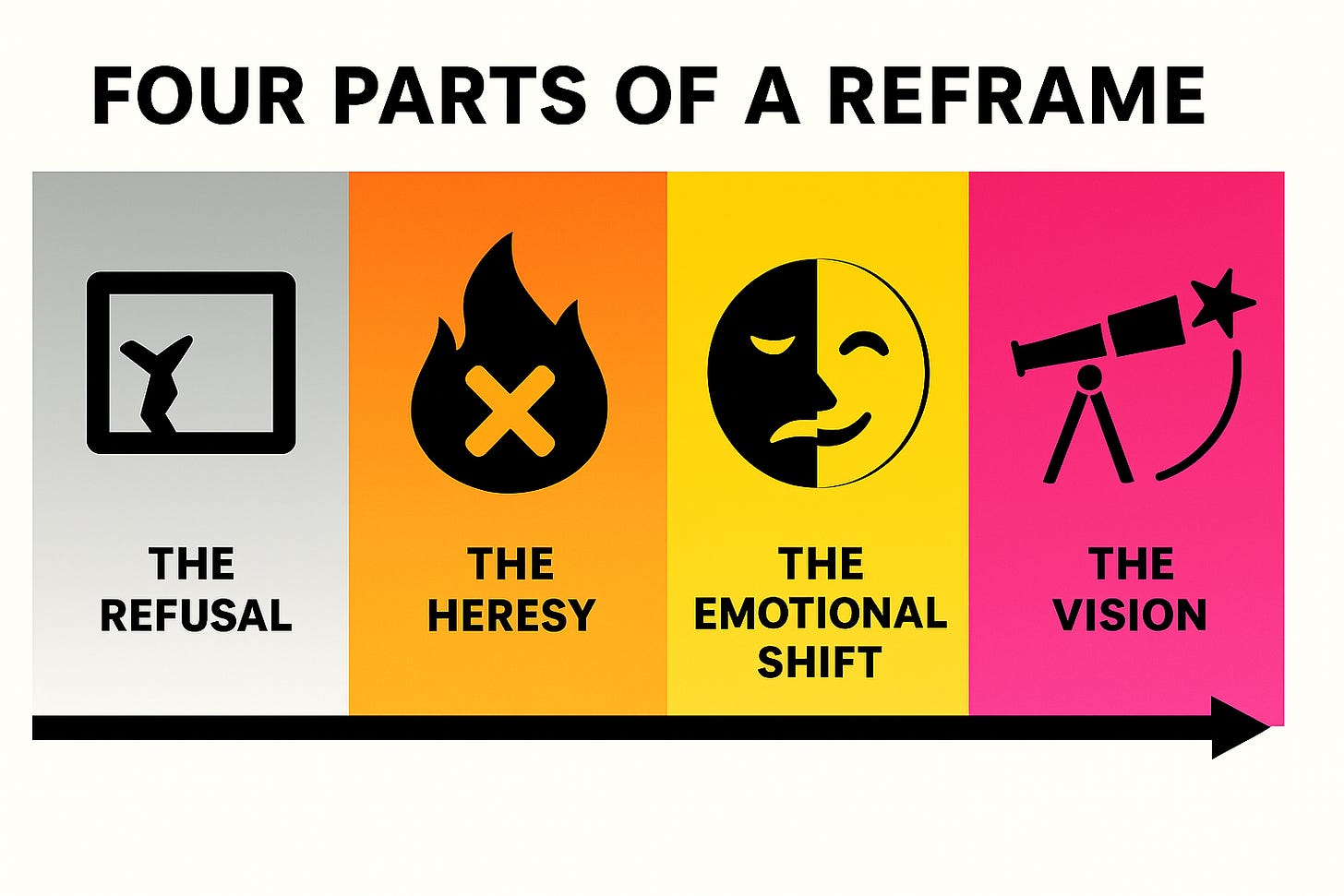The Reframe is the Startup
Startups are supposed to be about building. But the ones that break through don't just build. They shift how we see.
Why “Better” Doesn’t Break Through
Most startups try to win by being better than what already exists or leapfrogging their competitors. But real breakthroughs aren’t just step-change improvements. They’re rewritings of the rules.
That’s what a reframe does.
It doesn’t just make a product better. A reframe challenges the legacy logic of incumbents and proposes a new way of seeing.
Paradoxically, reframes rarely begin with big visions. They start with a subtle sense that something feels off. A strange friction. A crack in the story the world keeps telling.
Take Stripe.
Patrick and John Collison didn’t set out to optimize online payments. They were annoyed by how hard it was to accept payments as developers, but what they saw underneath the pain was bigger. Developers weren’t just dealing with clunky tools. They were being forced to think like retail clerks: bogged down in forms, banks, and compliance rituals. The system wasn’t broken. It was built for a world before the Internet existed.
Instead of polishing the interface, Stripe reframed payments as programmable infrastructure. Not just a transaction system. A code layer. That new lens made an entirely different future feel obvious.
That’s the power of the reframe. It doesn’t just make people want your product. It makes them wonder how they ever saw the world any other way.
Lens First. Product Second.
Behind every pattern-breaking product is a quiet shift in perspective.
Figma wasn’t just elegant design software. It began with a hunch: maybe design in a connected world should be multiplayer by default. That one shift in logic made the rest of the product fall into place.
Airbnb didn’t ask, “How can we build better hotels?” They asked, “What if anyone could be a host and any home could be hospitality?” That reframe didn’t just unlock unused bedrooms. It redefined who provides hospitality, what hospitality means, and how we come to trust strangers in unfamiliar places.
Breakthroughs start as irritations that won’t go away. Founders tug on threads without knowing where they’ll lead. And eventually, the old logic unravels — and something new comes into view.
Execution then amplifies the lens. But the wrong frame, flawlessly executed, digs a deeper hole. In contrast, the right new frame, even with a scrappy prototype, feels prophetic.
Why Reframes Create Breakthroughs: The Logic of Uncapped Upside
At the core of every breakout startup is not just a better product, but a better premise.
Reframes change the premise. And when the premise shifts, everything downstream … problems, priorities, purchase behavior … reshuffles.
Here’s the logic:
Frame → Perception of Value → Behavior → Market Potential
A startup that operates within an inherited frame is constrained by inherited expectations.
Even perfect execution competes for limited upside—because the market is already shaped, segmented, and spoken for.
But when you reframe:
You surface non-consumption (demand that wasn’t visible inside the old logic).
You create new buying criteria (people evaluate solutions using your lens).
You trigger behavioral shift (a change in what feels normal or necessary).
And you expand or redefine the market itself – sometimes turning a niche into a movement.
This is why reframes precede power laws. They don’t just make a product work. They make a new kind of value legible.
Without a reframe, you have no leverage. You’re optimizing within a system someone else designed. But with a reframe, you’re building the system others will optimize for.
Can You Name Your Reframe?
Polished startups often stall because they solve problems inside someone else’s worldview.
They’re faster, cheaper, and cleaner — but still trapped in the same assumptions.
To break out, ask:
What shift in perspective makes your product feel inevitable? If you can say it in one sharp sentence, you might be onto something real:
Stripe: Payments aren’t a hurdle… they’re a starting block for builders.
Figma: Design isn’t a handoff… it’s a live, shared space.
Airbnb: Hospitality isn’t a service… it’s a relationship between strangers.
If your logic still feels borrowed, it’s usually good to pause. Reframes don’t arrive in lightning bolts. They show up as stubborn questions, not-quite-right metaphors, or tiny frictions you can’t unsee.
Don’t rush to resolve the tension. Stay in it. Clarity lives on the far side of discomfort.
When the lens finally snaps into place, you won’t just have a product. You’ll have a worldview that makes your product feel obvious and makes the old frame look absurd.
The Reframe Is a Sanity Check
Some of the most dangerous startup ideas are the ones that sound right because they align with the current logic.
They win pitch contests. They sound smart on paper. But they’re trapped. They play by someone else’s rules, so the upside is capped from the start.
Reframe questions keep you from building castles in someone else’s sandbox:
What if this pain point only exists inside the wrong frame?
What if the real opportunity is changing what people believe is necessary?
If you’re not asking these questions, you might be accelerating straight into the comparison trap.
Make People Want Something Different
Paul Graham’s classic advice, “Make something people want”, still holds.
It’s not just a strategy. It’s a first principle.
But when you’re seeking a true breakthrough, you need more than demand. You need a shift in desire. Reframing doesn’t mean rejecting Graham’s idea. You’re still making something people want, but now you’re changing what they want in the first place.
A reframe rewires people’s expectations. It opens their eyes to a problem they didn’t know they had and a future they didn’t know they needed. That kind of want pulls harder. It hits deeper. It makes your product feel inevitable.
Reframes Don’t Just Build Startups… They Reshape Worlds
The most powerful breakthroughs across history began with a new way of seeing.
Einstein asked:
What if space and time aren’t fixed, but part of a single fabric?
That reframe didn’t just tweak Newtonian physics. It redefined the cosmos.
Picasso asked:
Why paint what’s just visible when the mind knows more?
That reframe shattered realism and birthed Cubism.
Breakthroughs in any domain — science, art, politics, business — arely emerge from “better.”
They emerge from seeing differently.
Change the Lens. Change the Game.
Startups don’t win just because they move fast. They win because they see what others don’t.
AI is further collapsing the gap between idea and execution. Speed isn’t the bottleneck anymore. Judgment is. Judgment about what you choose to build – what you believe is worth building – matters more than how fast you build it.
Execution multiplies vision. But only if the vision is sound.
So it’s good to pause long enough to ask:
What assumptions am I inheriting without realizing it?
What friction have we normalized that no longer makes sense?
What default feels quietly broken, but everyone tolerates?
These aren’t strategy questions. They’re reframe questions.
And if you pull hard enough – past the obvious, polished, and safe – you might find it: A shift in logic that makes a whole new kind of product feel inevitable. That’s what spreads. That’s what endures.
Not just the product. The lens.
If You’re Ready to Reframe
This is the first in a series of essays for founders who want to change the rules.
Here’s what’s next:
Refuse the Game — Expose the hidden assumption holding your market back.
Declare the Heresy — Say the thing no one else will. That’s where the energy is.
Trigger the Shift — Make people feel the change—not just understand it.
Spread the Future — When your lens becomes the default, your product becomes inevitable.
Find the right lens, and the product becomes obvious. Miss it, and you can build brilliantly… in the wrong direction.
This is the secret I’m betting on. Not just on the companies I think will win… but the ones who can escape competition altogether.








I see the Reframe as the practical application of the non-obvious, pattern-breaking insight. One of the key points is when your niche becomes a movement. We want our prospective partners to not be able to un-see our mission and face the choice to join a higher purpose or not.
Startups create new customers. They're not the new businesses doing something similar to what exists but merely better.